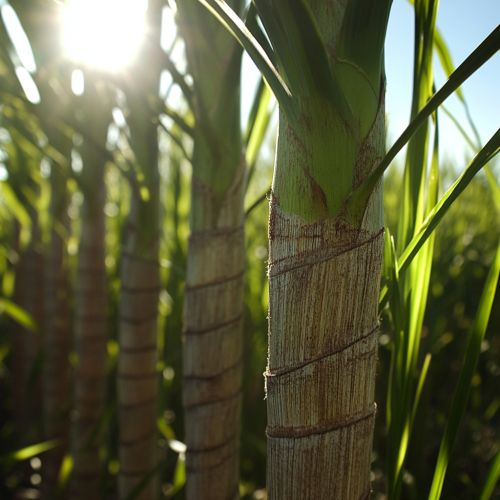Raw sugar
Introduction
Raw sugar is a partially refined sugar product derived from the juice of sugarcane or sugar beet. It is characterized by its coarse texture and light brown color, resulting from the presence of molasses. Unlike fully refined white sugar, raw sugar retains some of the natural molasses, which imparts a distinct flavor and color. This article delves into the production, composition, uses, and health implications of raw sugar, providing a comprehensive understanding of this ubiquitous sweetener.
Production Process
The production of raw sugar begins with the extraction of juice from sugarcane or sugar beet. The process involves several key steps:
Extraction
The extraction process involves crushing the sugarcane or slicing the sugar beet to release the juice. This juice contains sucrose, water, and various impurities. The extraction is typically performed using large mills or diffusion methods, which help maximize juice yield.
Clarification
Once extracted, the juice undergoes clarification to remove impurities. This is achieved by adding lime and heating the juice, causing impurities to coagulate and settle. The clarified juice is then filtered to remove the precipitated impurities, resulting in a clear liquid.
Evaporation
The clarified juice is concentrated through evaporation, which involves boiling the juice in multiple-effect evaporators. This process reduces the water content and increases the sucrose concentration, forming a thick syrup known as "massecuite."
Crystallization
Crystallization is a critical step in raw sugar production. The concentrated syrup is seeded with fine sugar crystals, promoting the formation of larger sugar crystals. The mixture is then cooled and stirred, allowing the crystals to grow.
Centrifugation
The crystallized massecuite is subjected to centrifugation, separating the sugar crystals from the remaining liquid, known as molasses. The sugar crystals are washed with water to remove any residual molasses, resulting in raw sugar.
Drying and Packaging
The final step involves drying the raw sugar to reduce moisture content, followed by packaging for distribution. The drying process ensures the sugar remains free-flowing and prevents clumping during storage.


Composition and Characteristics
Raw sugar is composed primarily of sucrose, with small amounts of glucose and fructose. The presence of molasses gives it a light brown color and a slightly caramel-like flavor. The molasses content also contributes trace minerals such as calcium, potassium, and iron, although these are present in negligible amounts compared to other dietary sources.
The texture of raw sugar is coarser than that of refined white sugar, with larger crystals that provide a distinctive crunch. This texture makes it a popular choice for certain culinary applications, such as baking and confectionery.
Uses and Applications
Raw sugar is used in a variety of culinary and industrial applications. Its unique flavor and texture make it suitable for:
Baking
In baking, raw sugar is often used to add texture and flavor to baked goods. Its coarse crystals create a crunchy topping for muffins, cookies, and cakes. The molasses content also enhances the flavor profile of these products.
Beverages
Raw sugar is commonly used as a sweetener in beverages, including coffee, tea, and cocktails. Its distinct flavor can complement the taste of these drinks, providing a more complex sweetness than refined sugar.
Industrial Uses
In the food industry, raw sugar is used as a sweetening agent in the production of various processed foods. It is also used in the fermentation process for the production of alcoholic beverages such as rum and certain types of beer.
Health Implications
The health implications of consuming raw sugar are similar to those of other forms of sugar. Excessive consumption can lead to health issues such as obesity, type 2 diabetes, and dental cavities. However, raw sugar does contain trace amounts of minerals due to its molasses content, though these are not significant enough to provide substantial nutritional benefits.
Moderation is key when incorporating raw sugar into the diet. It is important to balance sugar intake with other nutrients and maintain a healthy lifestyle to mitigate potential health risks.
Environmental Impact
The production of raw sugar has environmental implications, particularly in terms of water usage, land use, and energy consumption. The cultivation of sugarcane and sugar beet requires significant amounts of water and land, which can contribute to deforestation and habitat loss in certain regions.
Efforts are being made to improve the sustainability of sugar production through practices such as precision agriculture, which optimizes resource use, and the development of more efficient processing technologies. Additionally, some producers are exploring the use of renewable energy sources to reduce the carbon footprint of sugar production.
Economic Significance
Raw sugar is a major commodity in the global market, with significant economic importance for many countries. The sugar industry provides employment and income for millions of people, particularly in developing countries where sugarcane cultivation is a key agricultural activity.
The price of raw sugar is influenced by various factors, including weather conditions, global demand, and trade policies. Fluctuations in sugar prices can have significant economic impacts on producing countries, affecting both farmers and consumers.
